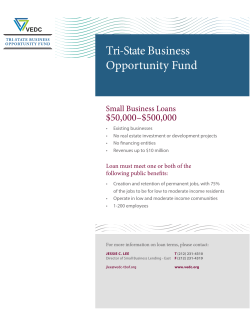
B Be Wise Before you Jumbo-Size (your Loan)
Be Wise Before you Jumbo-Size (your Loan) Olivia Ferguson B orrowers weren’t the only ones chafed by the strict fall-out regulations of the 2008 housing crisis. The heightened credit standards have shut many Americans out of the housing market, and lenders are likely to face a low supply of borrowers. In 2014, total mortgage lending declined, reaching its lowest level since 2008. The decline in lending reflects low demand among consumers and a drop in borrower refinancing, which significantly contributed to lenders’ revenues in 2013. Analysts suggest this is due to hikes in borrowing rates. However, amidst these industry challenges, jumbo loans have appeared as a bright spark in the market for lenders and wealthy borrowers alike, bringing the promise of large assets to lenders and offering those who can afford a luxury home a new and improved mortgage option. What is a jumbo loan? A jumbo loan is a mortgage of over $417,000 most often acquired in order to purchase large, singlefamily homes ranging from $750,000 to $10 million. 10 | C onsume r s’ Re sea rc h Spring 2015 The loans are non-conforming, meaning they are above the regulated limit for loans set by Fannie Mae and Freddie Mac, and are considered high risk due to the difficulty of reselling should the home face foreclosure. For these reasons, a borrower must typically have a credit score of at least 700 to qualify for a jumbo loan. In the past lenders have required higher scores, but many today accept as low as 680 in hopes of widening the scope of potential borrowers. What was the role of jumbo loans in the 2008 housing crisis? In 2008, with housing prices rising due to the swelling bubble, the number of jumbo loan applicants rose, as more and more consumers took on jumbo loans in order to buy moderately-sized homes. Essentially, many were qualifying for loans they could not afford. When prices subsequently fell, lenders upped their interest rates significantly, precluding many borrowers from being able to fund expensive homes, putting additional pressure on housing prices and further perpetuating the decline of the real estate market. Moreover, the rate of delinquency on jumbo mortgage owners sharply increased during this time and the years that followed. In January 2010, Bloomberg reported jumbo mortgages had reached a 9.6 delinquency rate, up from 9.2 percent the previous month, and further increased to 10 percent by February that year. Role Today? In the aftermath of the housing crisis, jumbo loans remained difficult to obtain. However, in recent years such loans have once again become more affordable and are appearing in the market more and more. In 2014, jumbo loan interest rates were lower than those of comparable conforming loans for 5 weeks in August and September. This, along with a growing economy, has spurred affluent consumers to once again take on jumbo loans for both primary and vacation homes. Inside Mortgage Finance reported that the jumbo share of the mortgage market grew to 19 percent in 2014 from 14.4 percent in 2013. This is the highest growth rate since 2002. According to lenders, part of this growth is due to new, lower down payment jumbo offerings which allow a larger number of first-time buyers to qualify for a loan. Many banks today offer jumbo loans with down payments of less than 20 percent (the industry standard). Who uses them and how has that changed? Geographically speaking, jumbo loans are most used in areas with high-paid professionals and housing markets with corresponding high-priced homes. Such areas include New York City, Washington, D.C., Silicon Valley, and Los Angeles. The largest market for jumbo loans is California (thanks, especially to Silicon Valley and Los Angeles), with Texas following in a close second due to heavy concentrations of highpriced homes in Houston, Dallas, and Austin. Who is borrowing these loans? The average borrower is 46 years old – two years older than in 2013 – and is likely to have a high-paying career. Jim Angleton, president of Aegis FinServ Corp., says, “Our typical jumbo loan is about $2.5 million and higher, and so the typical borrower is either going to be a corporation or is going to be the president, CEO or a high executive of a company.” How to Qualify for a Jumbo Loan? As mentioned, due to the high risk associated with jumbo loans, a high credit score is needed to acquire one. While some sources identify the minimum as 680, others require a better score. Mary Beth Rapice, real estate attorney for Pullman and Comley, says, “There is no [private mortgage insurance] with a jumbo mortgage, so the down payments are larger and, usually, the credit score can be no lower than 700… If you are going to apply for a larger mortgage amount, of course you’re going to have to be able to show the income and the assets in order to pay that.” For this reason, the maximum debt-to-income ratio required for these loans is 45 percent and borrowers must prove they have six months-worth of reserves in their bank account. But despite the strict requirements, rates are at historic lows and the interest on jumbo loans can lead to a $1 million tax-deductible. Competitive Lenders The growth in the jumbo loan share of the mortgage market is not just due to higher disposable incomes. Banks, seeking the income that comes from issuing loans, are creating the demand by pushing interest to the aforementioned low rates, as well as reducing the percentage demanded for a down payment. The industry standard is 20 percent, but many of the biggest banks, including Wells Fargo, JPMorgan Chase & Co., and Bank of America will allow customers to use assets, such as investment accounts, to reduce the down payment amount. Paul Miller, analyst at FBR Capital Markets Corp., notes, “Jumbos are growing while almost everything else is dead… Big banks need loan growth. If they were getting decent commercial loan growth, they wouldn’t be so aggressive on competing for jumbos.” Furthermore, the push by lenders for jumbo loans is in part because they do not have to pay high guarantee fees to Fannie Mae and Freddie Mac to ensure bonds, as they would for conforming loans. C onsum er s ’ R e s earch S pring 201 5 | 11
© Copyright 2025










